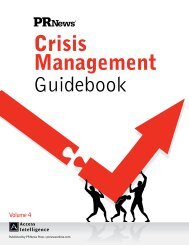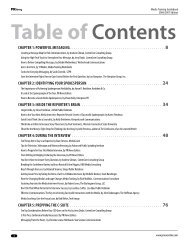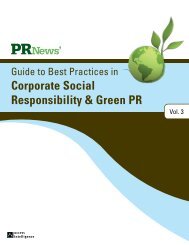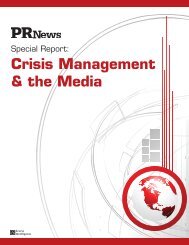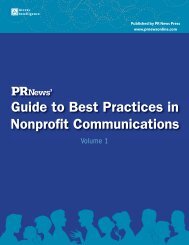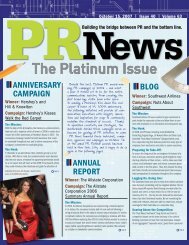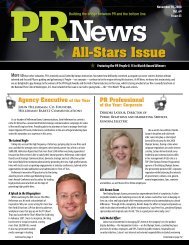ROI of Online Press Releases WhitePaper-DESIGNED - PR News
ROI of Online Press Releases WhitePaper-DESIGNED - PR News
ROI of Online Press Releases WhitePaper-DESIGNED - PR News
Create successful ePaper yourself
Turn your PDF publications into a flip-book with our unique Google optimized e-Paper software.
<strong>ROI</strong> <strong>of</strong> <strong>Online</strong> <strong>Press</strong> <strong>Releases</strong><br />
by Mihaela Vorvoreanu, PhD, 2008 Fellow, Society for New Communications Research<br />
The following is the executive summary <strong>of</strong> a research study conducted by a team <strong>of</strong><br />
Fellows <strong>of</strong> the Society for New Communications Research and made possible by support<br />
from Vocus. The full research report will soon be made available by SNCR.<br />
<strong>Press</strong> releases used to be one <strong>of</strong> the basic tools <strong>of</strong> the public relations pr<strong>of</strong>ession,<br />
used by <strong>PR</strong> practitioners to communicate news directly to journalists. With the advent <strong>of</strong><br />
new online communication channels, the goals, target audiences, and overall scope <strong>of</strong><br />
press releases have evolved, transforming press releases themselves into a new<br />
communication tool used by public relations and marketing pr<strong>of</strong>essionals alike.<br />
The purpose <strong>of</strong> this research study was to identify and analyze current patterns in the<br />
uses <strong>of</strong> online press releases. Specifically, the objectives <strong>of</strong> this study were to identify:<br />
! Goals <strong>of</strong> online press releases;<br />
! Target audiences <strong>of</strong> online press releases;<br />
! Criteria for evaluating the success <strong>of</strong> online press releases; as well as<br />
! Tactics, opportunities and challenges <strong>of</strong> using online press releases.<br />
Ultimately, the goal <strong>of</strong> the study is to examine the changing roles <strong>of</strong> public relations<br />
and marketing in the context <strong>of</strong> how the press release is being used as a tool used not only<br />
by <strong>PR</strong> pr<strong>of</strong>essionals but also by marketing pr<strong>of</strong>essionals and small business owners for a<br />
wide variety <strong>of</strong> purposes and objectives. Based on the study’s results, the SNCR Fellows<br />
have compiled a list <strong>of</strong> recommendations about the use and evaluation <strong>of</strong> online press<br />
releases and some observations about this evolving communications pr<strong>of</strong>ession.<br />
Methodology<br />
The study utilized in-depth structured interviews, a Web-based survey, and case<br />
studies. This executive summary presents and discusses the results <strong>of</strong> the survey. The indepth<br />
interviews and case studies will be made available by SNCR in the full research<br />
report.<br />
The survey was developed by the SNCR Fellows and administered by TWI Surveys<br />
during March 31-April 16, 2008. We sought the responses <strong>of</strong> pr<strong>of</strong>essional communicators<br />
who use or have used online news releases.<br />
Sample<br />
The survey received a total <strong>of</strong> 423 responses from marketing pr<strong>of</strong>essionals (32.9<br />
percent), <strong>PR</strong> pr<strong>of</strong>essionals (30.1 percent), small business owners (23.7 percent),<br />
Excerpted from JOURNAL OF NEW COMMUNICATIONS RESEARCH, Vol. III/Issue 1<br />
© 2008 Society for New Communications Research
epresenting mostly small (under $1 million revenue, 44.8 percent) and medium ($1-$10<br />
million revenue, 31.5 percent) organizations from various sectors: service/retail (52.6<br />
percent), technology (24.6 percent), as well as other sectors such as: nonpr<strong>of</strong>it,<br />
government, and manufacturing. The overwhelming majority or respondents work<br />
primarily in the United States (83.9 percent).<br />
Results<br />
Goals <strong>of</strong> <strong>Online</strong> <strong>Press</strong> <strong>Releases</strong><br />
The respondents’ top goals for online press releases indicated that the traditional<br />
goals <strong>of</strong> increasing an organization’s visibility and credibility and announcing news are<br />
now almost equally as important as new goals that traditional press releases could not<br />
have accomplished. These new goals include reaching customers directly, creating online<br />
content, and search engine optimization (SEO). (See Table 1.)<br />
Table 1.<br />
Beyond the unanimously agreed-upon goals <strong>of</strong> increasing visibility and credibility,<br />
the researchers noticed significant differences among communication pr<strong>of</strong>essions with<br />
regard to the goals <strong>of</strong> online news releases. While <strong>PR</strong> pr<strong>of</strong>essionals placed more<br />
importance on traditional goals such as announcing news and enhancing thought<br />
leadership, marketing pr<strong>of</strong>essionals reported SEO and reaching consumers as important<br />
goals for their online press releases. Small business owners were concerned with using<br />
the release as a sales tool and reaching customers directly.<br />
Audiences<br />
Both traditional media and new media emerged as the top two most important<br />
audiences respondents hoped to reach with their online press releases. Bloggers and new<br />
media followed traditional media in importance, but were a very close second, separated<br />
by only 0.28 points on a 1-5 scale. Following closely were consumers and customers,<br />
whether in B2B or B2C environments. (See Table 2.)<br />
Excerpted from JOURNAL OF NEW COMMUNICATIONS RESEARCH, Vol. III/Issue 1<br />
© 2008 Society for New Communications Research
Table 2.<br />
Who are the particular audiences for your online press releases?<br />
In terms <strong>of</strong> target audiences for online press releases, significant differences emerged<br />
between marketing and public relations pr<strong>of</strong>essionals. Although both marketing and<br />
public relations pr<strong>of</strong>essionals reported more than average importance for reaching<br />
traditional media, consumers, and webmasters that will repurpose the release, <strong>PR</strong><br />
pr<strong>of</strong>essionals were consistently more interested than marketing pr<strong>of</strong>essionals in reaching<br />
traditional media. Marketing pr<strong>of</strong>essionals were consistently more interested than <strong>PR</strong><br />
practitioners in reaching new media or consumers directly. For example, <strong>PR</strong><br />
pr<strong>of</strong>essionals rated the importance <strong>of</strong> reaching traditional media an average 4.53 on a 1-5<br />
scale, which is significantly higher than marketing pr<strong>of</strong>essionals’ rating <strong>of</strong> 3.82.<br />
Similarly, marketing pr<strong>of</strong>essionals rated the importance <strong>of</strong> reaching webmasters with an<br />
average 3.49 on a 1-5 scale, which is significantly higher than <strong>PR</strong> practitioners’ rating <strong>of</strong><br />
only 2.83.<br />
These results indicate that online press releases have been adopted as a<br />
communications tool by the marketing pr<strong>of</strong>ession, but are being used very differently<br />
than they have traditionally been used by public relations pr<strong>of</strong>essionals. It is possible that<br />
the traditional patterns <strong>of</strong> press release usage might keep public relations practitioners<br />
from adapting press releases to online contexts and new audiences.<br />
Evaluation<br />
The most frequently mentioned criterion for evaluating the success <strong>of</strong> online press<br />
releases was the number <strong>of</strong> times the release has been republished on websites (79.6<br />
percent), followed by the number <strong>of</strong> times the release has been viewed online (76.8<br />
percent), an article based on the release (75.4 percent), and media interview requests as a<br />
result <strong>of</strong> the release (74.2 percent). (See Table 3)<br />
Excerpted from JOURNAL OF NEW COMMUNICATIONS RESEARCH, Vol. III/Issue 1<br />
© 2008 Society for New Communications Research
Table 3.<br />
What are your criteria for measuring the success <strong>of</strong> online press releases? (multiple<br />
selections allowed)<br />
In terms <strong>of</strong> having the press release republished on other websites, the survey<br />
responses indicated that some websites are more highly valued than others. The most<br />
important types <strong>of</strong> websites for the republication <strong>of</strong> press releases were news portals such<br />
as Google <strong>News</strong> or Yahoo <strong>News</strong>. They received a 4.56 average importance score on a 1-5<br />
scale. <strong>News</strong> websites such as Reuters and Topix were the second most important type <strong>of</strong><br />
websites, with an average importance score <strong>of</strong> 4.27. Blogs and social media sites were<br />
ranked third in terms <strong>of</strong> importance, receiving a 4.01 importance score.<br />
Interestingly, although marketing and public relations pr<strong>of</strong>essionals seem to use<br />
online press releases differently, there were no statistically significant differences<br />
between the two in terms <strong>of</strong> the criteria they use for evaluating success. In fact, the<br />
evaluation criteria were homogenous across different size organizations and industry<br />
sectors as well. The only statistically significant difference identified young<br />
communication practitioners (under 30 years <strong>of</strong> age) as more interested than the other age<br />
groups in obtaining coverage on blogs and social media sites.<br />
These data show that the criteria used to evaluate the success <strong>of</strong> press releases<br />
measure message distribution and exposure, and are the electronic equivalent <strong>of</strong> press<br />
clippings. However, these metrics provide no information about higher-level success<br />
indicators such as audience receipt; message comprehension, recall, and acceptance; and<br />
behavior change. Simply put, the fact that a press release has been republished on a<br />
website <strong>of</strong>fers no certain evidence that the target audience actually read it, understood it,<br />
agreed with it and, if applicable, engaged in a different behavior (i.e. product purchase) as<br />
a result.<br />
Excerpted from JOURNAL OF NEW COMMUNICATIONS RESEARCH, Vol. III/Issue 1<br />
© 2008 Society for New Communications Research
Open-ended responses to a different survey question indicate that higher level<br />
indicators such as “eyeballs” and “dollar value” are desired evaluation criteria <strong>of</strong> online<br />
press releases, but communication pr<strong>of</strong>essionals do not know how to measure them. The<br />
researchers found these metrics interesting and worth further exploration and<br />
examination. These findings regarding metrics mirror what we have seen in our earlier<br />
studies <strong>of</strong> organizations using new communications tools and technologies in their<br />
communications initiatives, and may be indicative <strong>of</strong> the maturity level <strong>of</strong> the<br />
communications industry in terms <strong>of</strong> their understanding <strong>of</strong> how to best deploy and<br />
measure new and evolving communications tools and methodologies. We hope that this<br />
study will help to add to the knowledge base and provide some best practices for how<br />
both the <strong>PR</strong> and marketing pr<strong>of</strong>ession can think about new metrics.<br />
Tactics, Opportunities, and Challenges<br />
When asked to select the primary tactics used for issuing online press releases, 96<br />
percent <strong>of</strong> respondents indicated using a good headline/subhead with keywords. Making<br />
sure the content is interesting and newsworthy was the next most popular tactic, indicated<br />
by 91.5 percent <strong>of</strong> respondents. Including keywords in the body <strong>of</strong> the press release and<br />
using links to the corporate website in the release were other popular tactics, selected by<br />
87.9 percent and 86 percent <strong>of</strong> respondents, respectively. (See Table 4.)<br />
Table 4.<br />
What are the primary tactics you use when issuing a release for online distribution?<br />
(select all that apply)<br />
Excerpted from JOURNAL OF NEW COMMUNICATIONS RESEARCH, Vol. III/Issue 1<br />
© 2008 Society for New Communications Research
Only 57.8 percent <strong>of</strong> respondents indicated using SEO tactics, although some <strong>of</strong> the<br />
keywords and linking tactics in Table 4 are likely to help the release’s search engine<br />
rankings. This indicates a lack <strong>of</strong> knowledge about SEO on the part <strong>of</strong> most <strong>PR</strong><br />
pr<strong>of</strong>essionals, according to the researchers. Interestingly, very few respondents indicated<br />
using social media release formats (26.3 percent) and even fewer reported adding video<br />
(12.8 percent) or audio (9 percent) enhancements. Of all multimedia elements, photos<br />
were the most popular, used in online press releases by 49.5 percent <strong>of</strong> respondents.<br />
Even more puzzling is that less than half <strong>of</strong> respondents (48.8 percent) link to their<br />
own press releases after they have been posted online.<br />
According to respondents, the top opportunities for online press releases were the<br />
possibility to engage in SEO (34.1 percent) and the ability to reach both consumers<br />
directly and media (31.5 percent).<br />
One open-ended survey question asked respondents to identify challenges <strong>of</strong> online<br />
press releases. The open-ended responses were grouped into categories according to the<br />
main themes. The most frequently mentioned challenges were:<br />
1. Cutting through the clutter. This challenge speaks to the difficulty <strong>of</strong> getting a<br />
press release noticed in an information-rich environment.<br />
2. Targeting and distribution. Respondents <strong>of</strong>ten find it difficult to identify and<br />
target the specific audience for their press releases.<br />
3. Measurement. Accurate evaluation <strong>of</strong> online press release results to include not<br />
only message distribution and exposure, but also evidence <strong>of</strong> audience receipt<br />
and behavior change was another perceived challenge.<br />
Conclusion<br />
The survey responses indicate that online distribution is changing the nature <strong>of</strong> press<br />
releases, repurposing them into news releases used equally by <strong>PR</strong> and marketing<br />
pr<strong>of</strong>essionals alike as a communications tool to reach a multiplicity <strong>of</strong> audiences and<br />
achieve a number <strong>of</strong> goals. As opposed to traditional press releases, which were a channel<br />
for communicating only with the media, online press releases present the opportunity to<br />
reach the public directly. However, some challenges accompany this opportunity:<br />
! Ensuring that the public actually finds the press release online;<br />
! Adapting the writing style to multiple audiences (media and the public) while<br />
optimizing for search engine rankings;<br />
! Measuring the results and value <strong>of</strong> news releases<br />
Communication pr<strong>of</strong>essionals need to understand the opportunities and challenges <strong>of</strong><br />
online news releases and choose their options carefully. It might be unreasonable to<br />
expect that one release will accomplish all purposes for all target audiences. We expect<br />
that news releases will evolve into several specialized categories, such as:<br />
! Mainstream media releases<br />
Excerpted from JOURNAL OF NEW COMMUNICATIONS RESEARCH, Vol. III/Issue 1<br />
© 2008 Society for New Communications Research
! <strong>Online</strong> media releases<br />
! Social media releases<br />
! Consumer releases<br />
It will be a while before these specific types <strong>of</strong> news releases emerge and are taught<br />
in public relations courses. Until then, communication pr<strong>of</strong>essionals can use these sound<br />
and proven principles to maximize the benefits <strong>of</strong> news releases:<br />
1. Define your goal and target audience(s) in specific terms – What do you<br />
want to communicate? To whom?<br />
2. Define your evaluation criteria: How will you know that you have<br />
accomplished your goal? What does success mean for this particular news<br />
release?<br />
3. Research and understand your target audience(s) – Who are they? Where<br />
are they? What are they interested in? What do they read? What writing<br />
style is appropriate for them? What do they care about? Why should they<br />
care about your news?<br />
4. Create and distribute your news release.<br />
5. Track the news release’s impact; measure the results using the appropriate<br />
metrics.<br />
Mihaela Vorvoreanu (Ph.D., Purdue University) is a Research Fellow <strong>of</strong> the Society for New Communications<br />
Research. She is an Assistant Pr<strong>of</strong>essor <strong>of</strong> Communication Studies at Clemson University, South Carolina. Her<br />
research and teaching interests include public relations and new communication technologies, specifically the<br />
impact <strong>of</strong> online communication on public relations practice, culture, and society. Dr. Vorvoreanu’s research<br />
has been published in journals such as Public Relations Review and the Journal <strong>of</strong> Website Promotion, and in<br />
the book Web Site Public Relations: How Corporations Build and Maintain Relationships <strong>Online</strong>. Her thoughts<br />
on social media, public relations practice, and education are chronicled on her personal blog at<br />
http://www.prconnections.net.<br />
The research team for this study was comprised <strong>of</strong> SNCR Fellows Shel Holtz and Mihaela Vorvorneanu. The<br />
Society for New Communications Research thanks these individuals for their work on this study. In addition, the<br />
Society thanks the many participants in the survey and case study portions <strong>of</strong> the study and extends its<br />
appreciation to Vocus for its support <strong>of</strong> this research.<br />
Excerpted from JOURNAL OF NEW COMMUNICATIONS RESEARCH, Vol. III/Issue 1<br />
© 2008 Society for New Communications Research




